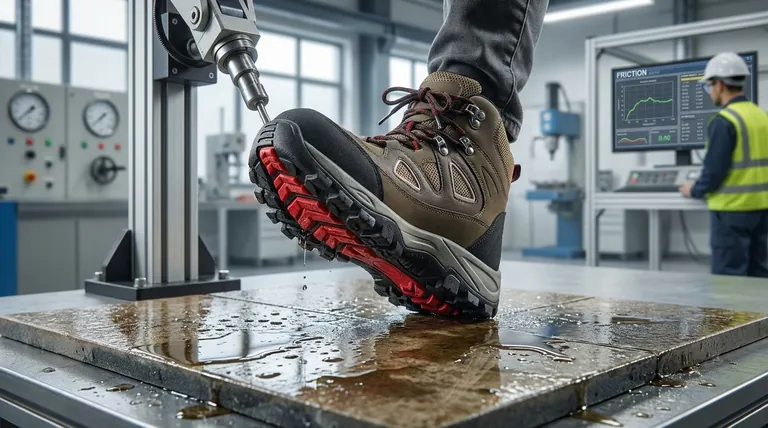The primary standards used to test slip resistance in footwear are the ASTM F2913 standard in North America and the SR marking in Europe. These standards are not subjective; they rely on a testing methodology known as SATRA to mechanically measure a shoe's coefficient of friction on standardized surfaces under controlled wet, dry, and oily conditions.
While many shoes claim to be "slip-resistant," true performance is verified by specific, measurable standards. Understanding these standards allows you to move beyond marketing claims and assess the actual safety profile of the footwear for your specific environment.

The North American Standard: ASTM F2913
The most prevalent standard for slip-resistant occupational footwear in the United States and Canada is ASTM F2913. This standard provides a clear, data-driven benchmark for performance.
What It Measures: Coefficient of Friction (CoF)
The entire test is designed to measure the coefficient of friction (CoF). Think of this as a numerical rating for the shoe's "grip" on a given surface. A higher number means more grip.
The Passing Threshold
To pass the ASTM F2913 test, a shoe must achieve a CoF of at least 0.40 on the specified test surfaces. This creates a clear pass/fail criterion for manufacturers.
The Testing Methodology (SATRA)
The standard uses the SATRA test methodology to ensure consistent results. This involves a machine that applies precise force and motion to the footwear.
The test is conducted on a standard surface (quarry tile) under three distinct conditions:
- Dry
- Wet
- Oily/Wet
Simulating a Natural Stride
Critically, the test doesn't just press the shoe flatly. It measures the CoF during two key phases of a walking stride: the heel strike and the forepart (toe-off), providing a more realistic assessment of performance.
Understanding International Markings
While ASTM is dominant in North America, you may encounter other markings, particularly on footwear from or for the European market. The key standard has recently evolved.
The Legacy Standards: SRA and SRB
Previously, you would see SRA (tested with a soap solution on ceramic tile) and SRB (tested with glycerol on a steel floor). A shoe passing both could be marked SRC.
The Current Standard: SR
This system has been simplified. The new SR marking indicates the footwear has passed a slip resistance test on a ceramic tile surface contaminated with glycerine. This test also simulates natural walking movements for a more accurate result.
Common Pitfalls to Avoid
It is easy to misinterpret the various codes and terms stamped on a work boot. Confusing these standards can lead to a false sense of security in hazardous environments.
Slip Resistance vs. Toe Protection
A very common point of confusion is mixing up slip standards with safety toe standards. ASTM F2413 is the specification for protective toe cap footwear. It covers impact and compression resistance, but it says nothing about the sole's grip. A boot can be ASTM F2413 compliant without being slip-resistant.
"Oil-Resistant" vs. "Slip-Resistant"
The term "oil-resistant" typically means the outsole's material will not degrade, crack, or swell when exposed to oils and chemicals. It is a durability rating. It does not guarantee the shoe will provide grip on an oily surface. For that, you need a specific slip-resistance rating.
How to Choose the Right Footwear
Your choice should be dictated by the specific hazards of your workplace. Use these standards to make an informed decision.
- If your primary focus is compliance in the US/Canada: Look for footwear that explicitly states it meets or exceeds the ASTM F2913 standard.
- If you work in a consistently wet environment: Ensure the chosen footwear has passed the wet tile portion of the ASTM F2913 protocol.
- If you work with oils, greases, or industrial chemicals: Prioritize footwear tested under oily/wet conditions (ASTM F2913) or with the newer SR marking.
- If you need comprehensive foot protection: Verify that the shoe carries separate ratings for both slip resistance (ASTM F2913) and safety toe protection (ASTM F2413).
By focusing on the specific standard that matches your environment, you can confidently select footwear based on proven performance.
Summary Table:
| Standard | Region | Key Test | Passing Threshold |
|---|---|---|---|
| ASTM F2913 | North America | SATRA method on wet/dry/oily surfaces | CoF ≥ 0.40 |
| SR Marking | Europe | Glycerine-contaminated tile | Pass/Fail based on simulated stride |
Need Reliable, Standards-Compliant Slip-Resistant Footwear?
As a large-scale manufacturer, 3515 produces a comprehensive range of ASTM-tested footwear for distributors, brand owners, and bulk clients. We ensure your footwear meets the highest safety standards for any work environment.
Contact us today to discuss your specific needs and receive a custom quote.
Visual Guide

Related Products
- Safety Footwear Wholesale Manufacturer for Custom OEM/ODM Production
- Wholesale Safety Footwear Manufacturer for Bulk & Custom OEM Orders
- Customizable Anti-Smash Safety Boots for Wholesale & Private Label Manufacturing
- Custom Wholesale Leather Safety Boots Direct Factory Manufacturing
- Premium Grain Leather Safety Boots for Bulk Supply
People Also Ask
- What do heavy duty boots do? Protect Your Feet in Demanding Work Environments
- Is safety-toe as good as steel toe? Choose the Right Protection for Your Job
- What cultural and environmental considerations are tied to wearing shoes indoors? Balance Hygiene, Tradition, and Foot Health
- Is it normal to wear shoes in the house? A Guide to Hygiene, Comfort & Culture
- What are the differences between steel toe, composite toe, and alloy toe Wellington boots? Choose the Right Safety Toe for Your Job



















